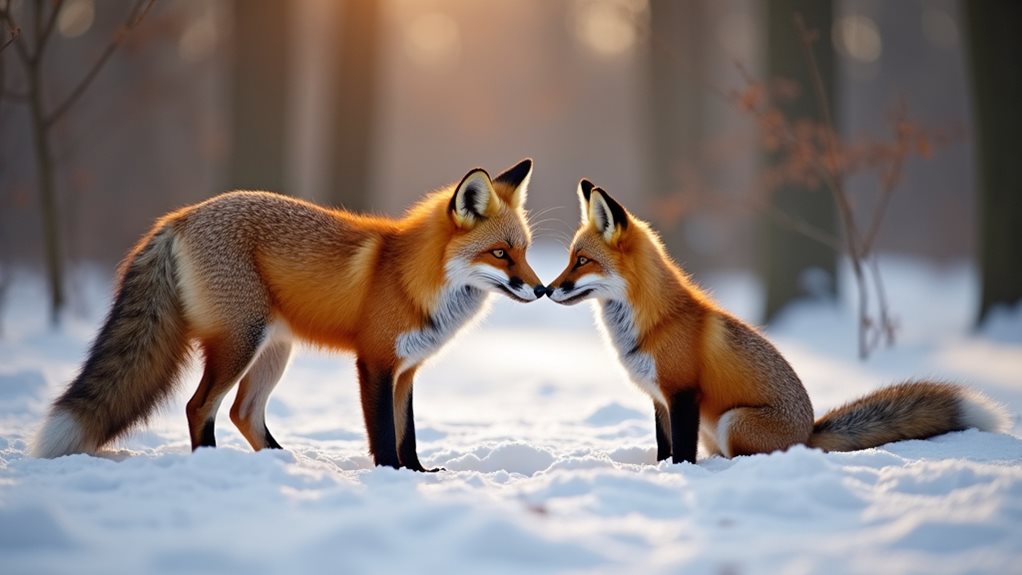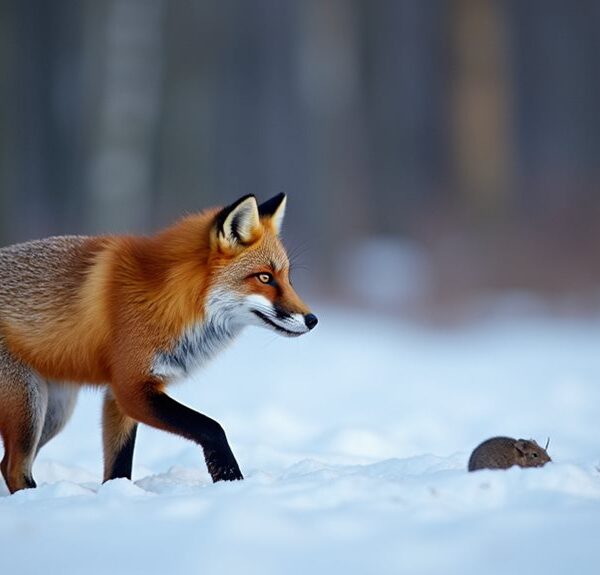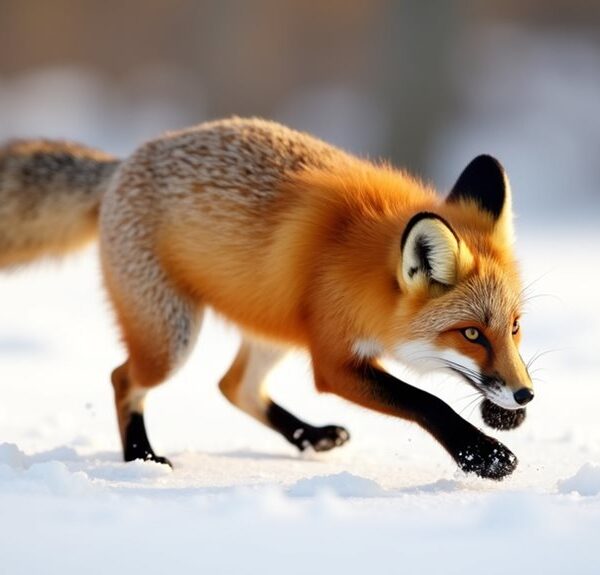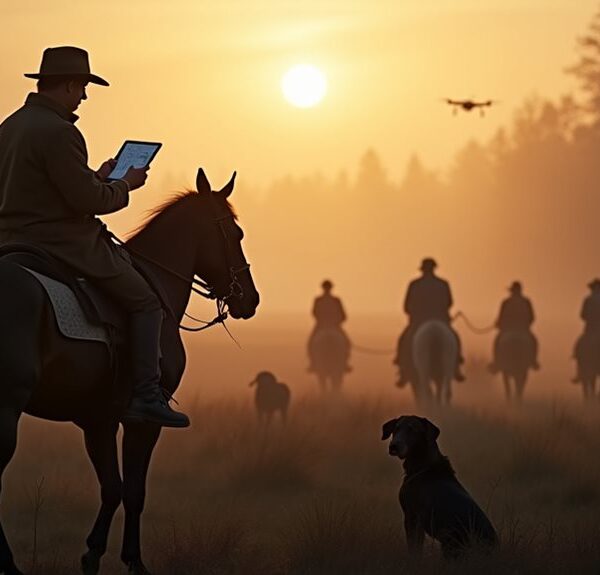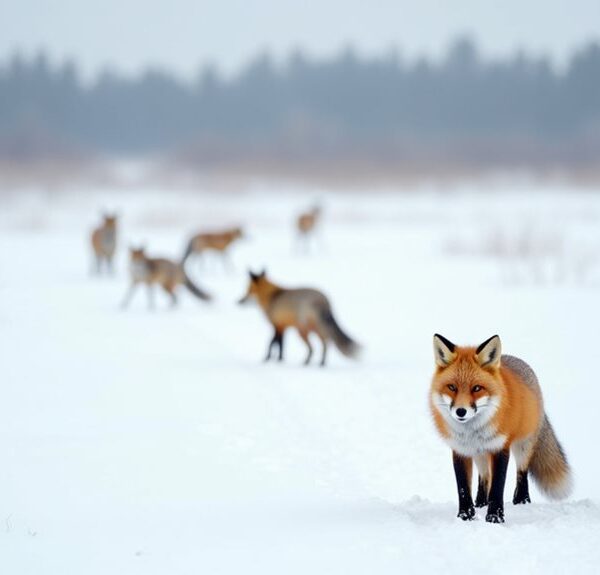Fox mating season typically occurs between December and February in North America, though you might spot courting foxes as early as November in the UK. The timing varies by region, with northern populations breeding earlier. Urban foxes often mate sooner than their rural counterparts due to artificial lighting and reliable food sources. You’ll know it’s mating season when you hear those distinctive, eerie screams echoing through the night. Discover what happens after those first romantic howls below.
Contents
- 1 The Timing of Fox Breeding Season Across Different Regions
- 2 Fox Mating Behaviors and Courtship Rituals
- 3 The Distinctive Sounds of Fox Mating Season
- 4 Physical Changes in Foxes During Breeding Season
- 5 Den Selection and Preparation for Fox Families
- 6 Fox Pregnancy and Gestation Period
- 7 Fox Kit Development and Family Life
- 8 How Human Activity Affects Fox Mating Patterns
- 9 Practical Tips for Coexisting With Foxes During Breeding Season
- 10 Final Thoughts
The Timing of Fox Breeding Season Across Different Regions

While foxes captivate our imagination year-round, their breeding habits follow distinct seasonal patterns that vary depending on where they live.
You’ll notice notable regional variations in fox mating periods, with northern populations typically breeding earlier than their southern counterparts.
In North America, red foxes usually mate between December and February, while in the United Kingdom, you might spot courting foxes as early as November.
These differences aren’t random—they’re driven by environmental factors like daylight hours, temperature, and food availability.
Urban foxes sometimes breed earlier than rural ones, thanks to artificial lighting and more consistent food sources.
During this season, males often engage in territorial behaviors to attract females and assert dominance.
If you’re hoping to observe fox courtship behaviors, you’ll need to adjust your expectations based on your location.
The clever creatures have adapted their most intimate life cycles to match the rhythms of their specific habitats.
Fox Mating Behaviors and Courtship Rituals
As foxes enter their breeding season, they engage in fascinating courtship rituals that you might be lucky enough to witness if you’re patient and observant.
During this time, males pursue females with incredible determination, often traveling miles beyond their usual territory to find a potential mate.
The courtship displays include playful chasing, distinctive vocalizations, and physical contact that resembles a dance between the pair.
You’ll notice males bringing food gifts to females they’re interested in, a charming gesture that showcases their hunting abilities.
These mating rituals can last for several weeks as the pair forms a bond.
The male fox will stick close to his chosen female, protecting her from competing suitors with fierce determination. Additionally, vocalizations during mating season play a crucial role, as male foxes use loud calls to assert their presence and attract females.
It’s truly one of nature’s most enchanting performances of dedication and survival.
The Distinctive Sounds of Fox Mating Season

During fox mating season, you’ll often hear eerie, high-pitched screams piercing through the night—a sound many describe as similar to a human scream.
These nocturnal calls serve multiple purposes, from attracting potential mates to warning rivals that they’re entering claimed territory.
You might also notice a range of other vocalizations, including barks, howls, and yips, which foxes use to communicate with each other throughout the breeding period. Additionally, this vocal activity is closely tied to the breeding cycle overview, as it aligns with the timing of their mating behaviors.
Nocturnal Screaming Calls
The eerie, blood-curdling screams that pierce the night during fox mating season might’ve you wondering if someone’s being attacked in your neighborhood.
Don’t worry—it’s just foxes looking for love! These haunting vocalizations are a key part of their nocturnal behavior during the breeding season.
Female foxes produce sharp, screaming calls that can travel impressive distances through the night air, advertising their readiness to potential mates.
Males respond with shorter, bark-like mating calls that create quite the midnight chorus in rural and suburban areas alike.
If you’ve ever been startled awake by these sounds, you’re experiencing one of nature’s most dramatic dating rituals.
While jarring to human ears, these screams serve a crucial purpose in fox reproduction and territory communication. During this time, their vocalizations increase to signal attraction and competition among males.
Territorial Vocalizations
While the nocturnal screams announce a fox’s romantic intentions, territorial vocalizations serve an entirely different purpose during mating season.
You’ll notice these distinctive territorial calls increase as foxes become more protective of their chosen breeding grounds.
When you’re out walking at dusk, you might hear a series of short, sharp barks—these are foxes setting boundaries through vocal communication.
They’re fundamentally saying, “This area is taken!” These calls help prevent unnecessary confrontations between competing males who are all hoping to find a mate.
Unlike the eerie screams, territorial vocalizations tend to be lower in pitch and more rhythmic.
If you’re lucky enough to witness this behavior, you’re experiencing one of nature’s oldest dating rituals—where finding love starts with claiming the perfect piece of real estate! This dance of territorial behavior is essential for maintaining the social structure and resource access among competing foxes.
Physical Changes in Foxes During Breeding Season
As foxes prepare for breeding season, their bodies undergo remarkable transformations that signal their readiness to mate.
You’ll notice male foxes developing more muscular frames and brighter fur colors, especially around their faces and tails. These physical adaptations serve to attract potential mates in the competitive dating scene of the fox world.
Female foxes experience noteworthy hormonal changes, with increased estrogen levels causing their scent glands to become more active. This change in scent lets males know they’re becoming receptive to breeding.
You might also spot both sexes grooming more frequently, maintaining their appearance to impress potential partners.
If you’re observing foxes in winter, you’ll see these changes coincide with their thicker winter coats, creating a striking appearance that’s both functional for survival and attractive for mating. Furthermore, during this time, dominant individuals typically ensure they are the only ones breeding within a social group, affecting the dynamics of reproduction among red foxes.
Den Selection and Preparation for Fox Families

Once breeding season approaches, foxes begin the important process of finding and preparing suitable dens for their future families.
As winter fades, foxes embark on their annual quest to locate and ready perfect dens for their soon-to-arrive offspring.
You’ll notice these clever animals often reuse existing burrows, saving precious energy for family preparation rather than digging from scratch. They’ll search for dens with multiple entrances, which provide crucial escape routes from predators once kits arrive.
Den selection isn’t random – foxes carefully choose locations near reliable food sources while maintaining distance from human activity.
A good fox den might be tucked into a hillside, hidden under tree roots, or even beneath abandoned structures. In addition, they favor well-drained, gravelly soil that ensures the structural integrity of their dens.
The expectant parents will clean out the chosen den, line it with soft grass and fur, and create a cozy nursery for their upcoming litter.
It’s fascinating how these wild canids transform simple holes into safe, comfortable homes for their growing families!
Fox Pregnancy and Gestation Period
After the den is properly prepared, the next chapter in a fox’s reproductive voyage begins.
Female foxes, or vixens, typically experience a gestation period of about 52 days. During this time, you might notice subtle changes in the vixen’s behavior as fox reproduction progresses.
The earliest pregnancy signs include decreased activity and increased appetite. As weeks pass, the vixen’s belly will gradually expand, and she’ll spend more time resting in or near the den.
You’ll also observe her becoming more protective of her territory, especially as the birth approaches.
Remarkably, foxes don’t show their pregnancy as obviously as domestic dogs do. Their thick fur often conceals their changing physique until the later stages. This is crucial as the vixen needs to conserve energy, much like Arctic foxes’ adaptations to survive harsh conditions.
If you’re lucky enough to spot a pregnant vixen, remember to keep your distance—this is a vital time in her life cycle.
Fox Kit Development and Family Life

The birth of fox kits marks the beginning of an extraordinary family adventure that transforms the once-solitary adults into dedicated parents. You’ll notice these blind, deaf, and helpless newborns develop rapidly, opening their eyes after 10-14 days and venturing outside the den by one month. Watch how kit development accelerates as they grow, with playful wrestling matches strengthening muscles and honing hunting skills they’ll need for survival. Fox family dynamics revolve around both parents’ involvement, with dad bringing food while mom nurses. As kits mature, you’ll see the whole family engage in grooming sessions and playful interactions that strengthen their bonds. The nurturing environment created by strong social bonds among family members plays a crucial role in the kits’ development and survival.
How Human Activity Affects Fox Mating Patterns
When you build that new subdivision or shopping center, you’re actually reshaping fox territories and forcing them to adapt their breeding behaviors. Urban development has pushed foxes to mate earlier in some regions, as they take advantage of more consistent food sources from human waste. Hunting pressures have also created noticeable shifts in fox reproduction. In areas with heavy hunting, you’ll find foxes producing larger litters – nature’s way of compensating for population losses. They’ve become more nocturnal during mating season too, changing their courtship rituals to avoid human detection. It’s remarkable how adaptable these creatures are!
As urban foxes exhibit increased bold behaviors with humans, it’s fascinating to witness their resilience as they navigate these changing landscapes. While we expand our footprint, foxes don’t disappear – they simply rewrite their romantic rulebook to survive alongside us.
Practical Tips for Coexisting With Foxes During Breeding Season
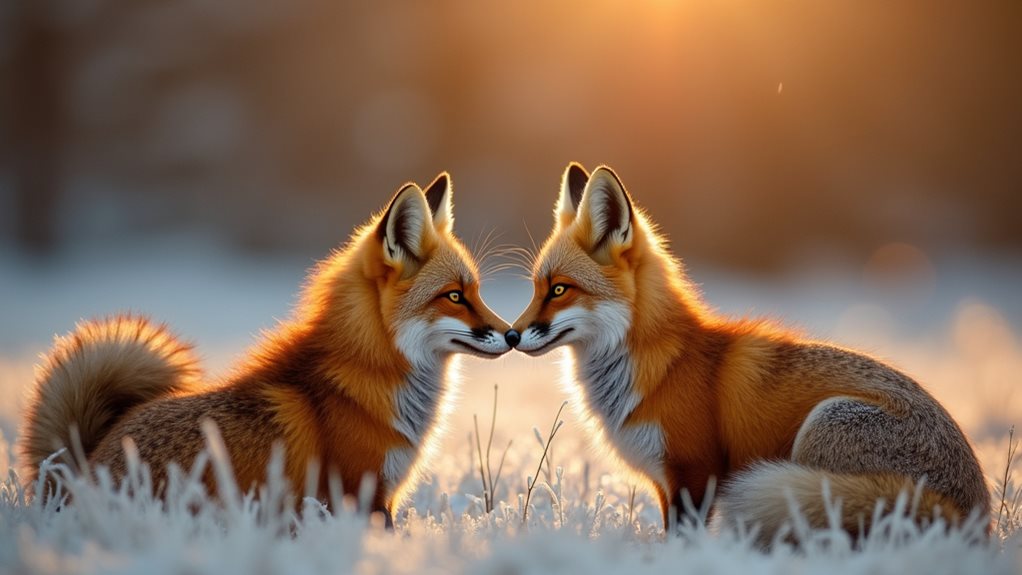
During fox breeding season, you’ll need some practical strategies to guarantee peaceful coexistence with these wild neighbors.
First, secure your garbage bins with tight-fitting lids or bungee cords to prevent foxes from foraging. Remove food sources like pet food and fallen fruit from your yard, as these attract hungry fox families.
For urban coexistence, maintain a respectful distance if you spot fox kits playing near dens. They’re adorable but should remain wild!
Installing motion-activated lights can gently discourage foxes from settling too close to your home.
Final Thoughts
You’ve now learned that fox breeding seasons vary widely depending on location and species. Did you know that red fox females are only receptive to mating for just 1-6 days per year? That’s an incredibly small window for such a significant life event! As you spot foxes in your neighborhood this season, you’ll recognize their behaviors with new understanding, helping you appreciate these adaptive creatures while giving them the space they need during this vital time.

